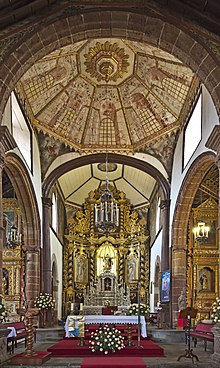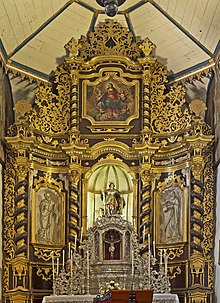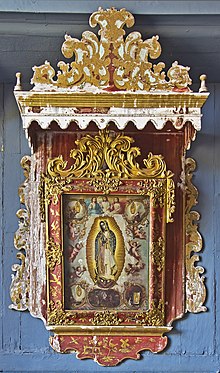Santa Catalina (Tacoronte)
The parish church of Santa Catalina Mártir de Alejandría is the main church in the city of Tacoronte in the province of Santa Cruz de Tenerife in the Comunidád Autónoma of the Canary Islands in Spain .
History of origin
In 1508 the conquistador and owner of a large part of the area of the present-day city of Tacoronte had a chapel built, which was dedicated to Saint Catherine of Alexandria . In the chapel was the stone carved sculpture that can be seen today on the south side of the crossing . A rectangular nave was added to this chapel in the middle of the century. The chapel was extended to a three-nave church in 1664. In 1694 the first floor of the tower with a baptistery was built. The tower in its current form was completed by the end of the 18th century. By relocating the stairs in the north aisle in 1780, the lower floor of the tower could be used as a baptistery without restrictions. In 1707 the aisles were changed and the choir was moved to the end of the main nave. Instead of a gate in the main nave, the aisles were given entrance gates. The crossing was provided with a "dome" by a Portuguese-influenced pseudo-architecture .
Main altar
The main altar was created in 1774 by the brothers José and Andrés Rodríguez from La Laguna . The side panels show Saint Peter and Saint Paul in grisaille painting . The sculpture of Saint Catherine comes from the Gran Canaria- born artist José Miguel Luján Pérez . The painting of an Annunciation from the 18th century forms the upper part of the altar .
Rosary Chapel
The rosary chapel is at the front of the south aisle. It is slightly wider than the aisle, so that together with the Chapel of the Immaculate Conception, a transept is created. The ceiling of the Rosary Chapel is divided into eight areas and decorated with concentric strips. On the multicolored background, the golden rosettes appear as an allusion to the pearls of the rosary. The altar was created by Antonio Álvarez and Melchor de Sosa in 1681. In the center it contains a sculpture of the Virgin from 1614. The baby Jesus was added in 1687. The sculptures of Saint Anthony of Padua and Saint Francis date from the 18th century. The paintings of Saint Joseph of Nazareth and Saint John were added to the altar in 1686. On the wall opposite the altar there are four pictures of angels showing different symbols: a lily, scepter and crown, a heart, a crown of roses. Further pictures with symbolic representations can be seen on the side wall.
Altar of the Virgen del Carmen
The baroque altar of the Virgen der Carmen, which is now in the south aisle, was the main altar of the church until the middle of the 18th century. The representation of the Virgin was created by José Miguel Luján Pérez in 1805.
Altar of the Holy Virgin (Purísima)
In the upper part of the Purísima altar there is a painting depicting Saint Bartholomew . The statue of the Virgin dates from the end of the 18th century. On the sides are depictions of Saint Anne and Saint Joachim . The lower part of the reredos is decorated with smaller representations of St. Augustine , St. Andrew , St. Bartholomew and St. Dominic .
Altar of Saint Joseph
The altar of Saint Joseph was created in 1750. Portuguese influences can be found in it, in which plastic and painterly elements combine without actually becoming illusion painting . In the upper part, on a painting depicting St. John Nepomuk , there is an inscription that indicates the donor. The picture and the altar were financed by José Espinosa Betancourt, who emigrated to America. The figure of Saint Joseph with the child is believed to have been made in America. The figure of Our Lady of Consolation, brought here from the Santuario del Cristo de los Dolores in 1961 , dates from the 17th or the beginning of the 18th century. The figure of St. Francis Xavier , which shows stylistic features of the 18th century, was also brought from the Santuario del Cristo de los Dolores to the Santa Catalina church in 1961.
Retable of Our Lady of Guadelupe
Opposite the altar of St. Joseph, on the wall of the choir, there is a retable of Our Lady of Guadelupe . The work was created in Mexico in the 18th century.
Choir and pulpit
A choir room is separated off in the western part of the main nave. There is an organ and the choir stalls in the colonial style of the 18th century. Above the seats there are panels with sayings and psalms in Latin. In 1724, a Baroque style pulpit was built into the main nave.
Chapel of Souls
At the western end of the north aisle is the Chapel of the Souls (Capilla de las Ánimas). The upper part of the altar from 1669 contains the painting The Souls in Purgatory (Ánimas del Purgatorio). It was created in 1729 by the painter Domingo de Quintana, who was born in Candelaria (Tenerife) . In the lower part there are sculptures of Saint Isidore , Saint Barbara and Saint Lucia .
Baptistery
In 1780 the stairs were moved from the basement of the tower to the aisle. At the same time, the entrance to the baptistery was provided with an altar-like entrance made of imitation marble. The ceiling of the baptistery used to have a pseudo-architecture - similar to the ceiling of the crossing. The baptismal font comes from a Genoese sculptor's workshop. It is decorated with angel heads, leaves and fruits. It was donated by the Tacoronte-born merchant Diego Antonio Marrero who emigrated to Cuba.
Christ altar
The Christ altar (Retablo del Cristo) created in 1708 was reworked by Domingo de Quintana in 1750. In the center of the altar is a group of figures with the crucified Jesus, Mary and John . The figures in the group come from different eras. The altar also contains various paintings.
Altar of Saint Anthony
In the center of the altar of Saint Anthony (Retablo de San Antonio) is a modern figure of the Sacred Heart of Jesus . On the sides there is a depiction of the flight into Egypt (Huida a Egipto) and an image of St. Didakus (San Diego de Alcalá).
Chapel of the Immaculate Conception
The Chapel of the Immaculate Conception (Capilla de la Concepción) is located at the eastern end of the north aisle. It is slightly wider than the aisle and thus forms part of the transept. On the wooden ceiling of the chapel there are strong influences of the Mudejar style . The altar was given its present form in 1776. In the center of the upper part there is a figure of Saint Lawrence (San Lorenzo), flanked by paintings depicting Saint Catherine and Saint Philip . In the lower part of the altar there are figures of Saint Rita , Saint Andrew and a Virgin of Candelaria .
Individual evidence
- ↑ ANUNCIO de 16 de febrero de 2005 (PDF; 80 kB) March 2, 2005, accessed on November 14, 2012 (Spanish).
- ^ Clementina Calero Ruiz: José Luján Pérez . Viceconsejeria de Cultura y deportes, Gobierno de Canarias, Santa Cruz de Tenerife 1991, ISBN 84-7947-050-X , p. 84 (Spanish).
- ↑ Manuel Hernández González: Tenerife, Patrimonio Histórico y Cultural . Editorial Rueda, Madrid 2002, ISBN 84-7207-134-0 , p. 102 ff . (Spanish).
- ↑ ANUNCIO de 16 de febrero de 2005 (PDF; 80 kB) March 2, 2005, accessed on November 14, 2012 (Spanish).
- ^ Carlos Rodrígez Morales ;: Cristóbal Hernández de Quintana . Gobierno de Canarias, Santa Cruz de Tenerife 2002, ISBN 84-7947-348-7 , p. 155 (Spanish).
literature
- Carlos Rodrígez Morales: Cristóbal Hernández de Quintana . Gobierno de Canarias, Santa Cruz de Tenerife 2002, ISBN 84-7947-348-7 , p. 155 ff . (Spanish).
Web links
Coordinates: 28 ° 28 '57.8 " N , 16 ° 25' 4.5" W.





